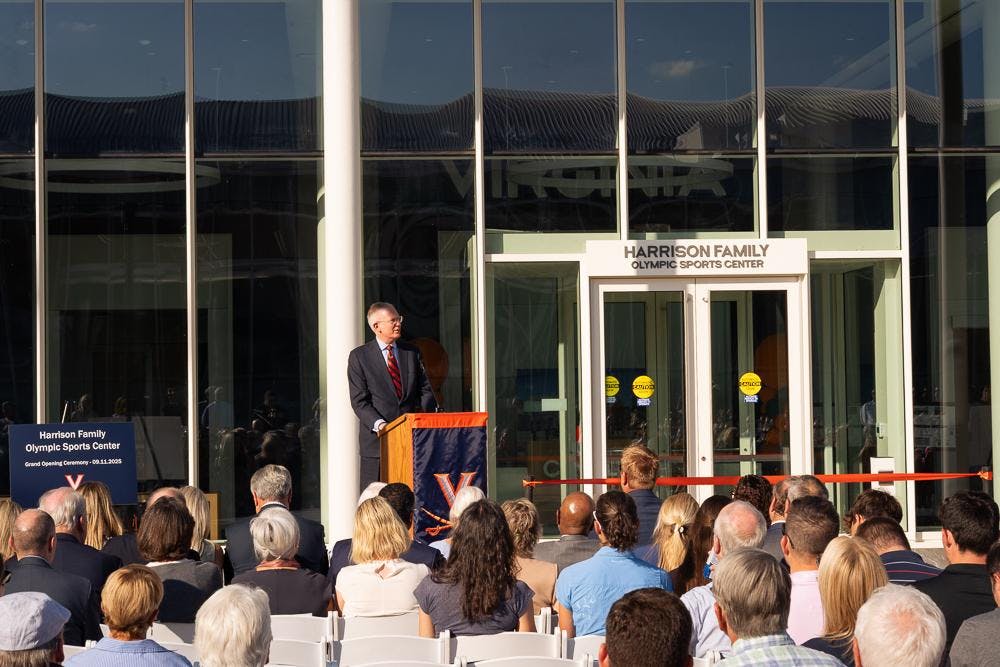“Nothing great is accomplished alone,” Athletic Director Carla Williams said.
Well, as it turns out, there is a lot that can be accomplished together — such as winning national championships while one’s program is housed in a trailer.
Since November 2018, eight of the University’s athletic programs — men’s and women’s soccer, men’s and women’s lacrosse, men’s and women’s track and field, field hockey and rowing — have had suboptimal facilities. Their locker rooms were in trailers. Why?
Those less-than-ideal accommodations were a necessary placeholder while a new state-of-the-art facility was being built to replace University Hall — the Harrison Family Olympic Sports Center.
Thursday, that project came to fruition when Virginia Athletics opened the luxurious doors of the OSC to members of the Board of Visitors, donors, Virginia Athletics alumni, media and the programs that will call it home. Hundreds of student-athletes attended the opening celebration before being allowed to tour the facility, and multiple speakers offered remarks.
The building bears the Harrison name in honor of Mary and David Harrison, benefactors who had donated over $150 million to the University throughout their lives. David Harrison was a Virginia Athletics alumnus himself, having played on the football team in the 1930s. The Harrison name also adorns the field at Scott Stadium, among other prominent University spaces.
The OSC features new locker rooms and lounges, a 12,800 square-foot strength and conditioning room, a hydrotherapy room, a rowing room, an outdoor terrace and team meeting rooms.
With the capacity to house eight programs, the OSC will transform the way many of those programs operate — just ask women’s soccer Coach Steve Swanson, who spoke at the event.
“Perhaps most importantly, this facility will help us continue to attract the best student-athletes from around the country and globe who are committed to getting a world class education and competing at the very highest level of collegiate athletics,” Swanson said.
According to Kevin Miller, executive director of the Virginia Athletics Foundation and deputy athletic director, the OSC will begin fully operating in the next few weeks.
But while the OSC is, by itself, a major development, it is also part of something bigger. The OSC is the final addition in the Virginia Athletics Master Plan, which was set in 2018, and was intended to revolutionize the University’s Athletic Grounds.
“This is a tumultuous time, as alluded to [by the speakers at the podium] today in college athletics,” Miller said. “And we're just trying to make sure that we're able to amass the resources necessary for Virginia to continue to be elite.”
The Master Plan, which originated under the leadership of former University President Jim Ryan, concludes under Interim President Paul Mahoney. Thursday’s ceremony marked Mahoney’s first Virginia Athletics-related public appearance as interim president.
“I'd like to express my gratitude to the Harrison family and to every donor who made it possible for these young people to pursue their dreams in the classroom, on the playing surface and in their lives after college,” Mahoney said. “I simply cannot thank you enough.”
The Master Plan began with Phase I — highlighted by the creation of the Training Grounds, demolition of outdated properties such as University Hall, a new parking lot outside the McCue Center and the construction of two football practice fields. Next, in Phase II, came the $80 million Hardie Football Operations Center, which opened in June 2024.
The OSC marks one of the final additions of the Master Plan. Now, there is just one last garnish in the form of an additional parking structure located across from John Paul Jones Arena, and the trailers will be replaced with more natural grass fields, according to Erich Bacher, associate athletics director for athletic communications.
As for the student-athletes who will greatly benefit from the OSC, Cavalier representatives expressed gratitude. Junior midfielder Mia Abello of the field hockey team and senior midfielder Umberto Pelà of men’s soccer were selected to speak on behalf of Virginia’s student-athletes and expressed sincere gratitude.
“The Harrison Center is not simply an opportunity for us to reach new limits,” Abello said. “But even more than that, it's a challenge — a challenge to show up every day and give relentless effort.”
Abello has been to a Final Four back in 2023, a season in which her team’s facilities were housed in the old trailers. Pelà, meanwhile, has yet to experience a Final Four. However, Pelà is well aware that being a student-athlete is about much more than performing on the field. Performing in practice facilities is important, but performing in classrooms is most important.
“There's a competitive drive here that's hard to spot unless you live it,” Pelà said. “Which brings me to today, the Harrison Olympic Sports Center isn't just a new building. It means raising the standard even further for what it means to compete at U.Va. For us as student-athletes, it's more than walls, fields and equipment room. It represents opportunity.”
“Opportunity” is a buzzword of Williams’, a hallmark of Virginia Athletics. And, Virginia now has a massive opportunity to compete with the nation’s very best and attract recruits with the OSC. At a minimum, Williams expects the Cavaliers to reign over the ACC — as per usual.
“During their displacement, [the eight teams housed in trailers] accounted for two national championships, five individual national championships, eight NCAA Final Fours and 10 ACC championships,” Williams said.
But regardless of on-field results, the OSC will enhance the student-athlete experience. Swanson explained that, as selfless ambassadors of the University, the Cavaliers have earned it.
“Win or lose, there is an investment here at Virginia from our student-athletes that you just don't see at other institutions,” Swanson said. “Investment from our student-athletes, not only to themselves, but to their teammates, and above all this University, our student-athletes love competing for the University of Virginia, and they are fully invested in the process of competing for national championships.”







